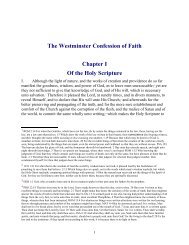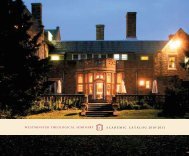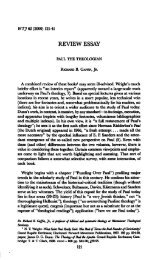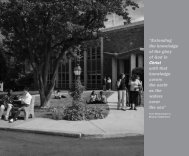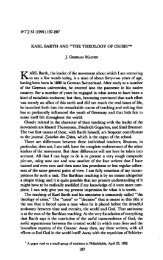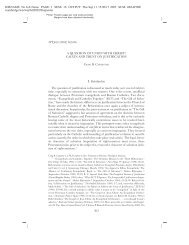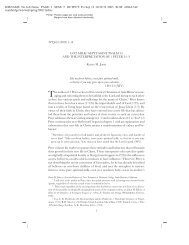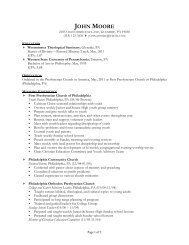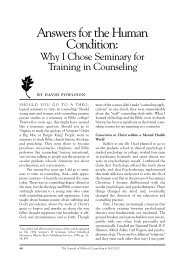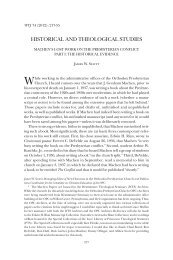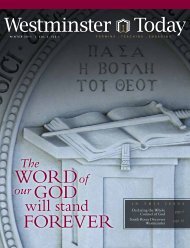2009 - 2010 Academic Catalog - Westminster Theological Seminary
2009 - 2010 Academic Catalog - Westminster Theological Seminary
2009 - 2010 Academic Catalog - Westminster Theological Seminary
You also want an ePaper? Increase the reach of your titles
YUMPU automatically turns print PDFs into web optimized ePapers that Google loves.
{About <strong>Westminster</strong>}<br />
J. Alan Groves Center for Advanced Biblical Research<br />
The J. Alan Groves Center for Advanced Biblical Research applies<br />
computing and related technology to the study and teaching of<br />
the Bible and its original languages. It was formed in 1986 as an<br />
outgrowth of ongoing research in the area of the Hebrew Bible<br />
and computing at <strong>Westminster</strong> under the executive direction of<br />
Professor J. Alan Groves. Currently the Groves Center is directed<br />
by Dr. Kirk Lowery, a Hebraicist with skills in both linguistics and<br />
computing, and Assistant Director Stephen Salisbury, a software<br />
developer with skills in computer science and Hebrew. Additionally,<br />
scholars from around the world contribute to this research.<br />
In the area of teaching, the Groves Center sponsors (bi-annually)<br />
a seminar in Hebrew Text-Linguistics. (Usually this is offered in<br />
the spring semester, but occasionally it is offered as a special<br />
seminar during January. See Hebrew Text-Linguistic Seminar in the<br />
Old Testament section of the Ph.D. course descriptions—OT 742 or<br />
743, depending on the semester offered.) The Groves Center also<br />
serves as a resource center for the academic research needs of<br />
faculty and students in Hebrew and related study. It is noteworthy<br />
that the Groves Center participated in some of the earliest attempts<br />
at computer-aided instruction for the Hebrew language.<br />
Concerning research in Hebrew and computing, the Groves<br />
Center authors, contributes to, or consults on these ongoing<br />
projects:<br />
• The electronic <strong>Westminster</strong> Leningrad Codex (WLC). This<br />
text began as an electronic transcription by Richard Whitaker<br />
(Princeton <strong>Seminary</strong>, New Jersey) and H. van Parunak (University<br />
of Michigan, Ann Arbor) of the 1983 printed edition of Biblia<br />
Hebraica Stuttgartensia (BHS). Work continued with the cooperation<br />
of Robert Kraft (University of Pennsylvania) and Emmanuel<br />
Tov (Hebrew University, Jerusalem), and was completed by<br />
Professor J. Alan Groves. The transcription was called the<br />
Michigan-Claremont-<strong>Westminster</strong> Electronic Hebrew Bible and<br />
was archived at the Oxford Text Archive (OTA) in 1987, but has<br />
been variously known as the “CCAT” or “eBHS” text. Since that<br />
time, the text has been modified in many hundreds of places<br />
to conform to the photo-facsimile of the Leningrad Codex,<br />
Firkovich B19A, which resides at the Russian National Library<br />
in St. Petersburg; hence the change of name to <strong>Westminster</strong><br />
Leningrad Codex. The Groves Center continues to scrutinize and<br />
correct this electronic text as a part of its continuing work of<br />
building morphology and syntax databases of the Hebrew Bible,<br />
since correct linguistic analysis requires an accurate text.<br />
• The Groves-Wheeler <strong>Westminster</strong> Hebrew Morphology (senior<br />
editor: Dr. Lowery; editor: Steve Salisbury). With seed funding<br />
from the Packard Humanities Institute (PHI), a team of<br />
<strong>Westminster</strong> scholars under the direction of Professor Groves<br />
began in 1987 to perfect a computerized version of the morphological<br />
analysis of the Hebrew text. We say perfect, because<br />
the basis for the text was a machine-produced analysis done by<br />
Richard Whitaker (Claremont, Princeton <strong>Seminary</strong>), who used the<br />
IBYCUS system to develop a parser that provided a trial parsing<br />
for about 95 percent of the words of the Hebrew Bible. While<br />
much editing was required, this initial analysis provided an excellent<br />
beginning database from which to build the database that<br />
exists today. The first version of the morphology was released in<br />
<strong>2009</strong>–<strong>2010</strong><br />
13



